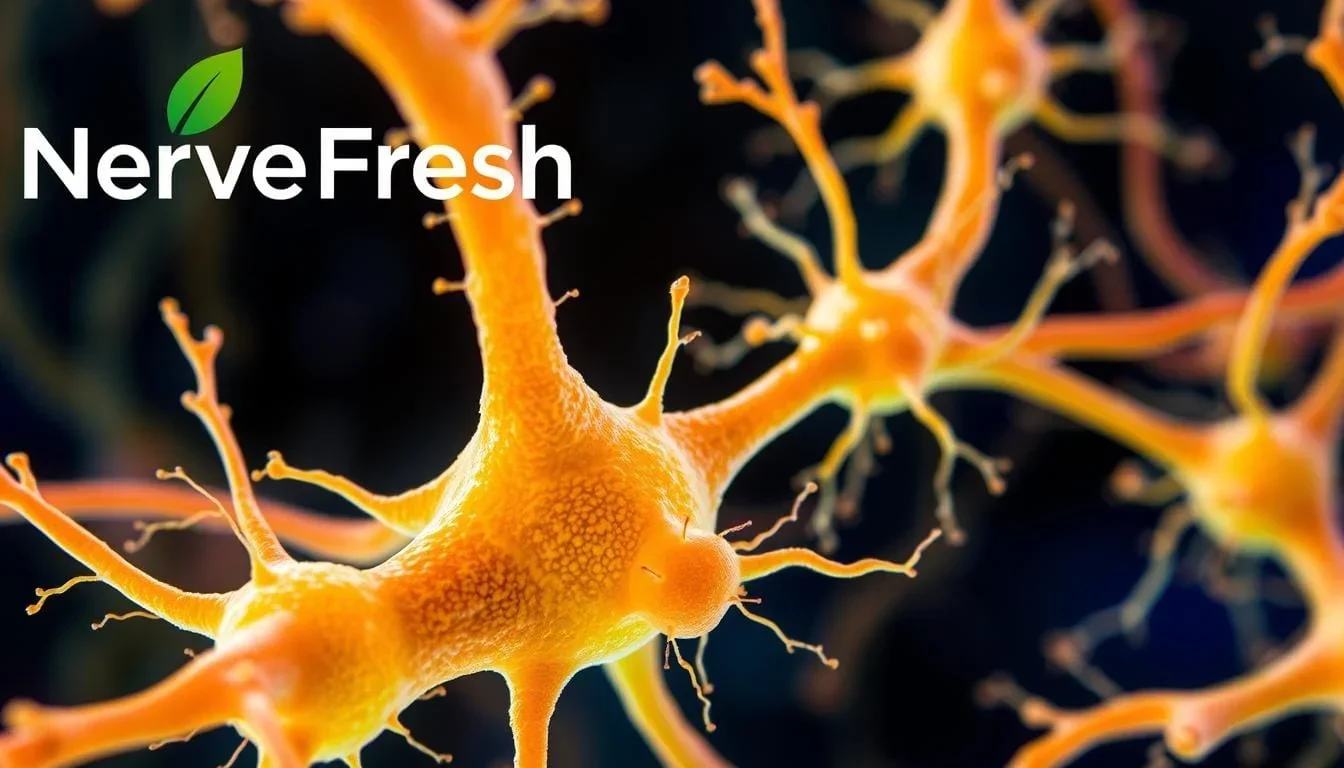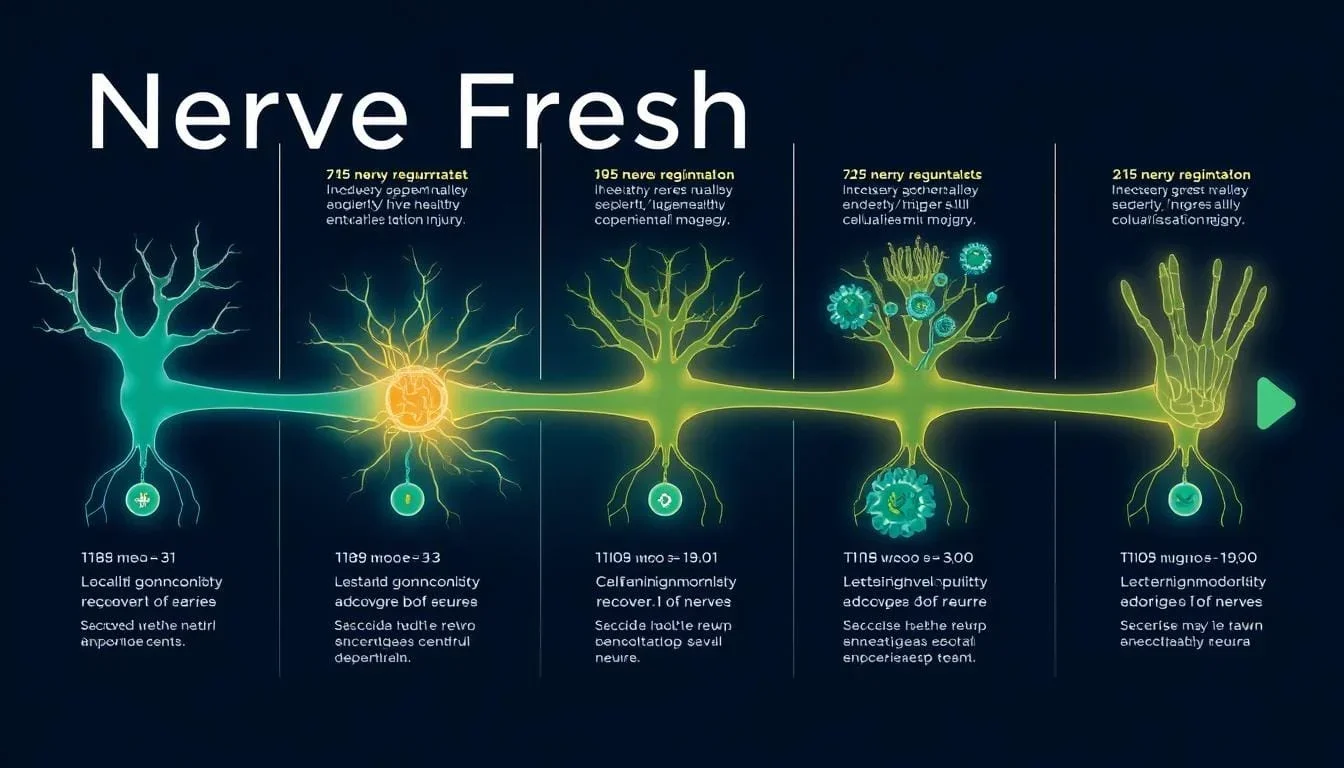Categories:
Ever wondered how your body can heal from nerve damage? The nervous system is vital for our daily life. Nerve damage can cause pain, numbness, and loss of function. This guide will show you how to help your body heal and repair nerves.
Nerve damage can come from injuries, diseases, or repetitive stress. Knowing how to heal is important for recovery. Whether it’s a pinched nerve or more serious damage, we’ll give you tips on how to repair and heal nerves.

Healing nerve damage is a complex process. It involves cellular responses and external support. Nutrition and physical therapy are key to successful nerve regeneration. We’ll explore the science behind nerve repair and share practical steps to help you heal.
Want to take charge of your nerve health? Visit Nerve Fresh for natural solutions to repair and regenerate nerves.
Key Takeaways
- Nerve injuries can affect both sensory and motor functions
- Recovery time varies based on factors like age and injury severity
- Proper nutrition plays a critical role in nerve repair
- Physical therapy and exercise can aid in nerve regeneration
- Early intervention is key for optimal nerve healing outcomes
- Lifestyle modifications can support ongoing nerve health
- Natural treatments and advanced therapies offer hope for nerve damage recovery
Understanding the Complexity of Nerve Damage
Nerve injuries can change a person’s life. They happen to people of all ages. These injuries can greatly affect your lifestyle, work, and daily functions. It’s important to know how nerve damage works.
Types of Nerve Injuries and Their Impact
Nerve injuries vary in severity. The mildest is Grade I, or neurapraxia, caused by mild pressure. The most severe is Grade V, or neurotmesis, where the nerve is completely cut.
| Injury Grade | Description | Recovery Potencial |
|---|---|---|
| Grade I (Neurapraxia) | Mild compression or traction | Good |
| Grade V (Neurotmesis) | Complete nerve transection | Poor without surgery |
The Role of the Peripheral Nervous System
The peripheral nervous system is vital for sending signals between your brain and body. Nerve fibers differ in size and speed. Fastest are large motor neurons, while slowest are unmyelinated neurons.
Common Symptoms and Warning Signs
Knowing the signs of nerve damage is important. Look out for:
- Numbness or tingling sensations
- Muscle weakness
- Pain in affected areas
- Dry skin in the affected region
If you notice these symptoms, see a doctor right away. Early treatment can help a lot and prevent serious problems later.
For more on nerve health and recovery, check out Nerve Fresh. It’s your go-to for all things nerve repair and regeneration.
The Science Behind Nerve Regeneration
Nerve regeneration is a complex process that happens after injury. Your body has amazing healing powers to fix damaged nerves. But, it’s a slow journey. Let’s dive into the fascinating science behind this process.
Cellular Response to Nerve Injury
When a nerve gets hurt, your body starts a series of cellular responses. The damaged nerve changes its structure. This is called Wallerian degeneration, which is key for axon regeneration.
| Regeneration Phase | Duration | Key Events |
|---|---|---|
| Initial Response | Hours to Days | Wallerian degeneration begins |
| Axon Regrowth | 1 mm/day | Slow regeneration of injured neurons |
| Gene Expression Change | 6 months | Downregulation of regeneration-associated genes |
The Role of Schwann Cells
Schwann cells are vital for nerve regeneration. They change to support growth, helping axons to regenerate. They make neurotrophins and adhesion molecules, while reducing myelin-associated proteins.

Natural Healing Mechanisms
Your body uses natural ways to repair nerves. Neurons adjust by changing proteins for neurotransmission and rebuilding. This can take months or even years, depending on the injury’s severity.
“Nerves recover slowly, and maximal recovery may take many months or several years.”
Knowing these processes helps in finding effective treatments for nerve injuries. For more info on nerve regeneration and treatment options, visit the Nerve Fresh official website.
How Long Does it Take for Nerves to Heal
Nerve healing time can vary a lot. It depends on the injury’s type and how severe it is. Your journey to recovery can take weeks, months, or even years. Knowing how nerves grow helps you understand your healing process better.

For minor injuries like neurapraxia, recovery usually takes 6-8 weeks. More serious injuries, like cut nerves, start healing about a month after they happen. Nerves grow at a rate of about 1mm per day.
Pinched nerves affect 85 out of 100,000 adults each year. They can last from a few days to 6 weeks. As you get older, you’re more likely to get pinched nerves because of changes in your body, like bone degeneration and arthritis.
| Injury Type | Average Recovery Time | Growth Rate |
|---|---|---|
| Neurapraxia | 6-8 weeks | N/A |
| Cut Nerves | Months to years | 1mm per day |
| Pinched Nerves | Few days to 6 weeks | N/A |
Your recovery might include symptoms like pins and needles or numbness. Burning pain can actually mean your nerves are healing. A healthy lifestyle, proper care, and exercises are key to supporting your nerve recovery.
The Critical Role of Proper Nutrition in Nerve Repair
Good nutrition is key to fixing nerve damage. Eating foods rich in vitamins and minerals for nerves helps a lot. Also, foods that fight inflammation can speed up your healing.

Essential Vitamins for Nerve Health
B vitamins are very important for nerves. Foods like sardines, salmon, tuna, green peas, and lentils are full of B vitamins.
- Sardines
- Salmon
- Tuna
- Green peas
- Lentils
Alpha-lipoic acid (ALA) is in green leafy veggies. It helps with nerve pain and growing new nerves. Research shows it boosts antioxidants and improves nerve function after injuries.
Minerals That Support Nerve Function
Some minerals are vital for healthy nerves. Magnesium and chromium help with blood sugar and insulin. This lowers the chance of nerve damage from high blood sugar.
| Mineral | Food Sources | Benefits for Nerve Health |
|---|---|---|
| Magnesium | Almonds, spinach, avocado | Supports nerve signal transmission |
| Chromium | Broccoli, grape juice, whole grains | Aids in blood sugar regulation |
Anti-inflammatory Foods for Recovery
Eating foods that fight inflammation helps your nerves heal. Omega-3s in fish, flaxseeds, and walnuts are great for this. They also help with blood sugar and nerve health.
Curcumin in turmeric is good for nerve repair. Studies in rats show it helps nerves grow back after injuries.
Eating a diet rich in these nutrients helps your nerves heal and recover better. It’s all about eating the right foods for your nerves.
Natural Treatment Approaches for Nerve Damage

Looking into natural ways to fix nerve damage can change your life. What you eat is very important for your nerves. Foods like tuna and salmon, full of vitamin B12, keep your nerves healthy. Spinach, rich in vitamin B6, helps your nerves talk to each other.
Eating foods that fight inflammation is also key. Ginger helps with pain, and berries and cherries have antioxidants that reduce swelling. These foods help your nerves work better.
Drinking enough water is also essential for your nerves. It helps them relax and recover. Some people use essential oils like eucalyptus or lavender for extra help.
“Nature itself is the best physician.” – Hippocrates
Acupuncture is becoming more popular for nerve pain. It works by using pressure points to change how your body feels pain. Exercise is also important, helping with conditions like peripheral neuropathy.
Even though natural methods can help, always talk to a doctor before trying them. Your path to better nerve health might include different natural treatments that fit your needs.
Physical Therapy and Rehabilitation Techniques
Physical therapy for nerves is vital for healing and recovery. Nerve rehabilitation programs are tailored to address different types of nerve damage. They help patients regain function and improve their quality of life.
Exercise Programs for Nerve Recovery
Exercise is a key part of nerve rehabilitation. These programs keep muscle strength up and prevent muscle loss during healing. Low-impact cardio like brisk walking, water aerobics, and stationary bike use help nerves heal faster. Resistance exercises also help rebuild strength.

Massage and Manual Therapy Benefits
Massage and manual therapy are important in nerve rehabilitation. They improve blood flow, reduce pain from nerve damage, and aid healing. These hands-on methods help stimulate nerve function and support the body’s natural healing.
Movement Patterns for Healing
Specific exercises are designed to stimulate nerve function and promote regeneration. These exercises improve balance, coordination, and flexibility. Physical therapists may use lateral raises, walking lunges, and table slides in treatment plans to meet individual needs.
A typical physical therapy session for nerve damage lasts 30-60 minutes. The frequency depends on treatment progress and injury severity. Sessions may be one to three times a week, with each lasting 30-45 minutes for specific exercises.
“Tingling, itching, and an ‘electric’ sensation are common signs of nerve healing.”
Recovering from nerve injury takes time, often several months. Being patient and consistent in physical therapy is essential for the best results. For personalized nerve rehabilitation programs, visit the American Physical Therapy Association to find a qualified therapist near you.
Surgical Options and Advanced Treatments
When nerve damage is severe, surgery is often the best choice. Nerve repair surgery can bring lasting relief for many with peripheral nerve injuries. With 43 pairs of peripheral nerves from the spinal cord, surgery can be complex but very rewarding.

Direct nerve repair is usually the first option for surgeons. This method involves carefully stitching or gluing the nerve ends together. For bigger gaps, nerve grafting fills the space. If reconnecting isn’t possible, nerve transfer uses a healthy nerve from another part of the body.
Nerve surgery is often needed after serious accidents, like those involving fast cars or heavy machinery. It’s also used for nerve tumors and when nerves get trapped. After nerve repair surgery, recovery is slow. Nerves grow about 1 inch a month in young, healthy people.
“Nerves regenerate constantly at any age, but not immediately and not with the same capability as before.”
New nerve treatments are being developed. Platelet-rich plasma is showing promise in fixing long nerve gaps. Allograft and conduit methods are also being explored as alternatives to traditional autografts. These new methods aim to better results and faster recovery times.
For more details on nerve surgery and advanced treatments, check out the American Association of Neurological Surgeons website.
Lifestyle Modifications to Support Nerve Health
Your lifestyle is key to keeping your nerves healthy and helping them repair. By choosing wisely, you can make your environment better for your nervous system.
Sleep and Rest Requirements
Sleep is vital for fixing nerves. Try to get 7-9 hours of good sleep each night. Make a calming bedtime routine and stick to it. While you sleep, your body fixes itself and helps your nerves grow back.
Stress Management Techniques
Too much stress can hurt your nerves. Use methods like deep breathing, meditation, or yoga to relax. These activities calm your mind and help your body heal, keeping your nerves healthy.
Daily Activities Adjustment
Change your daily habits to protect your nerves. Steer clear of actions that might bother damaged nerves. Take breaks and keep a good posture. Light exercise, like walking or swimming, boosts blood flow and helps your nerves.

- Quit smoking and limit alcohol intake
- Maintain a healthy weight
- Follow a Mediterranean-style diet rich in whole grains, vegetables, and fish
- Stay hydrated
- Engage in 150 minutes of physical activity weekly
| Lifestyle Factor | Impact on Nerve Health |
|---|---|
| Quality Sleep | Activates natural healing mechanisms |
| Stress Management | Reduces inflammation and supports nervous system |
| Regular Exercise | Improves circulation and encourages nerve regeneration |
| Balanced Diet | Provides essential nutrients for nerve function |
Being consistent with these changes is important. Your nerves will appreciate the care and effort you put into these healthy habits.
Preventing Further Nerve Damage
It’s important to protect your nerves from more harm while they heal. Your daily habits can help a lot in preventing nerve damage. By making smart choices, you support your body’s healing and keep your nerves healthy.
Avoid activities that might hurt the affected area. Good posture is essential to prevent nerve compression. Use proper ergonomics in your daily tasks to reduce nerve strain. For example, set up your workstation to keep your spine in a neutral position.
Managing health conditions is key for nerve health. If you have diabetes or an autoimmune disorder, work closely with your doctor. Regular check-ups help monitor your nerve health and catch issues early.
- Avoid prolonged gripping to prevent further damage
- Stay away from hot objects to avoid burns or blisters
- Engage in controlled exercises to improve blood flow to damaged nerves
- Start graded strengthening programs as your nerves show signs of recovery
Nerve healing takes time. Cut nerves can regrow at about 1mm per day after an initial degeneration period. Be patient and keep up with your efforts to protect your nerves. Your hard work will pay off in the long run.
For more detailed guidance on protecting nerves and maintaining nerve health, visit Nerve Fresh, your trusted resource for nerve health information.
Monitoring Progress and Recovery Milestones
It’s key to track nerve healing progress for effective treatment. Recognizing nerve recovery signs and milestones is vital. This helps keep you motivated and lets healthcare providers tweak your treatment.
Signs of Nerve Regeneration
Signs of nerve healing include less pain, better sensation, and muscle function coming back. You might feel tingling or a “pins and needles” feeling. These are good signs of healing.
When to Consult Healthcare Providers
Regular visits to your healthcare provider are a must to check on nerve healing. See them if symptoms change suddenly or if progress slows. They might suggest tests like nerve conduction studies or electromyography to check nerve function.
Tracking Improvement Methods
Keep a journal to track your nerve recovery. Use pain scales to rate your discomfort and note any changes in sensation or muscle strength. Your doctor might use tests to track your progress. This helps show how far you’ve come.
“Monitoring nerve healing progress is a team effort between you and your healthcare provider. Stay vigilant and communicate any changes you notice.”
Nerve healing takes time. Celebrate small wins and be patient on your journey to full recovery. For more on nerve health and recovery, check out the National Institute of Neurological Disorders and Stroke website.
Conclusion
Nerve repair and healing is a complex journey that needs patience and a multi-faceted approach. Your recovery path involves understanding nerve damage, eating right, and doing tailored physical therapy. This overview shows how a complete strategy is key to fixing nerve injuries.
Statistics reveal that 83% of those with peripheral nerve injuries are under 55, with an even split between men and women. Nerves grow about an inch a month, showing the slow but steady progress. This highlights the need for ongoing care and monitoring.
Your nerve damage recovery is special. Things like age, health, and injury severity affect how fast you heal. By using medical treatments, making lifestyle changes, and staying up-to-date with research, you’re on the right path. For more on nerve repair, check out the official Nerve Fresh website.
FAQ:
For the topic “Nerve Fresh: Essential Guide to Heal and Repair Nerve Damage”
Q: What is Nerve Fresh and how does it help with nerve damage?
A: Nerve Fresh is a dietary supplement designed to support nerve health and promote nerve healing. It contains a blend of ingredients that may help nourish nerve cells, reduce inflammation, and create a healthier environment for the nerves. While it’s not a cure, Nerve Fresh works to support the body’s natural healing processes and may help relieve nerve pain associated with various types of nerve damage.
Q: What are the common symptoms of nerve damage?
A: Symptoms of nerve damage can vary depending on the type and severity of the injury. Common signs of nerve damage include numbness, tingling sensations, burning pain, muscle weakness, and loss of sensation. In some cases, people may experience more severe symptoms like difficulty moving affected limbs or chronic pain. If you’re experiencing these symptoms, it’s important to consult with a healthcare professional for proper diagnosis and treatment.
Q: Can damaged nerves heal on their own?
A: In some cases, damaged nerves can heal on their own, particularly if the injury is minor. The body has a natural ability to regenerate nerve cells, but the process can be slow. Peripheral nerve injuries may have a better chance of healing compared to injuries to the brain and spinal cord. However, the extent and speed of healing depend on various factors, including the severity of the damage and the overall health of the individual.
Q: How long does nerve healing typically take?
A: The time it takes for nerves to heal can vary greatly depending on the extent of the damage and the specific nerve affected. In general, nerves grow back at a rate of about 1 inch per month. Minor nerve injuries may heal within a few weeks, while more severe damage can take several months to years for full recovery. It’s important to note that some nerve injuries may not heal completely, and patience is key during the recovery process.
Q: Is nerve repair surgery always necessary for nerve damage?
A: Nerve repair surgery is not always necessary for nerve damage. Many cases of nerve damage can be treated with conservative methods such as physical therapy, medication, and lifestyle changes. However, in more severe cases where there is a complete nerve severing or significant compression, surgery may be required. The decision for nerve surgery depends on factors such as the location and extent of the damage, as well as how the injury responds to non-surgical treatments.
Q: What sets Nerve Fresh apart from other nerve health supplements?
A: Nerve Fresh sets itself apart through its comprehensive formula that targets multiple aspects of nerve health. The Nerve Fresh formula includes a blend of vitamins, minerals, and herbal extracts specifically chosen for their potential to support nerve function and promote healing. Unlike some other supplements that may focus on a single aspect of nerve health, Nerve Fresh aims to provide a more holistic approach to supporting nerve regeneration and reducing nerve-related discomfort.
Q: Can Nerve Fresh help with all types of nerve pain?
A: While Nerve Fresh is designed to support overall nerve health, it may not be equally effective for all types of nerve pain. It can potentially help with various forms of neuropathy and nerve discomfort, including peripheral nerve injuries and some cases of chronic pain. However, it’s important to note that Nerve Fresh is not intended to diagnose, treat, cure, or prevent any disease. For severe or persistent nerve pain, especially conditions like complex regional pain syndrome, it’s crucial to consult with a healthcare professional for appropriate treatment.
Q: How quickly can I expect to see results from using Nerve Fresh?
A: The time it takes to experience results from Nerve Fresh can vary from person to person. Some users may notice improvements in their nerve-related symptoms within a few weeks, while others may require several months of consistent use. It’s important to remember that nerve healing is a gradual process, and the effectiveness of Nerve Fresh may depend on factors such as the severity of nerve damage, overall health, and lifestyle habits.
Q: Are there any side effects associated with using Nerve Fresh?
A: Nerve Fresh is generally well-tolerated, as it’s made from natural ingredients. However, as with any supplement, some individuals may experience mild side effects. It’s always recommended to read the ingredient list carefully and consult with a healthcare provider before starting any new supplement regimen, especially if you have pre-existing health conditions or are taking other medications.
Q: Can Nerve Fresh be used alongside other treatments for nerve damage?
A: In many cases, Nerve Fresh can be used alongside other treatments for nerve damage, such as physical therapy or prescribed medications. However, it’s essential to inform your healthcare provider about all supplements you’re taking to ensure there are no potential interactions. Nerve Fresh is designed to complement a comprehensive approach to nerve health, but it should not replace any treatments prescribed by your doctor.
Related Articles:
- Mitolyn Review 2025: Is This Weight Loss Supplement Worth the Hype?
- NeuroQuiet Review: My 90-Day Journey with Tinnitus Relief!
- ZenCortex Review: Do ZenCortex Drops Really Work? Find Out Here!
- GlucoBerry Reviews: Does Blood Sugar Support Supplement Really Work?
- Puravive Weight Loss: Honest Analytical Customer Reviews
- Sugar Defender Reviews and Complaints: Blood Sugar Support Insights
Our Partners: CSKDesignCrafts.com – DesignersReport.com – LifeCraftsCentre.com
This post may contain affiliate links which means I may receive a commission for purchases made through links. There is no additional charge to you! Thank you for supporting my blog so I can continue creating free content each week!







